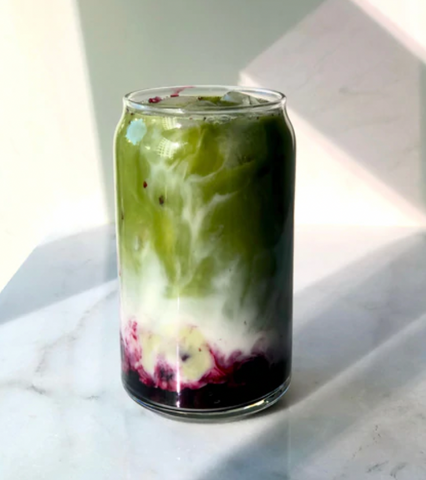Matcha is a great way to get in that morning caffeine without the jitters and energy crash of coffee, but what if we told you that there were different grades of matcha and that you might be buying the wrong one?
Matcha grades are actually really important to a lot of elements when it comes to taste, price, and color. If you are trying to save some money and make your lattes at home with minimal sugars and added ingredients, you’ve come to the right place. We’ve started talking about Matcha grades on our Tik Tok, but let’s break it down in writing.
So.. what is Matcha?
Matcha is different than any other green tea you’ve probably had. It’s made by taking whole green tea leaves and grinding them into a bright powder that, when combined with hot water, allows you to consume the tea in its whole form. Its origins date back to the 15th century when it was the primary drinking tea in traditional Japanese and Chinese cultures. The green tea plants used for matcha are traditionally grown in the shade for three to four weeks where the leaves are able to develop the natural caffeine that even many die-hard coffee lovers are starting to sip on. By depriving the leaves of their normal sunlight levels, farmers are able to increase the chlorophyll levels in the leaves and create a vibrant green which makes for a rich and flavorful tea. Only the finest and most mature leaves are chosen for the matcha before being laid out flat to dry. The leaves are then de-veined, de-stemmed, and stone-ground into a beautiful and bright green tea powder known as matcha.

The Difference Between Matcha and Typical Green Tea
Matcha green tea has been deemed by many as one of the healthiest beverages out there, outweighing all other white, black, or green teas. What makes matcha so incredible is that, unlike typical green teas which are consumed only after steeping its leaves it in water and discarding them, matcha is consumed in its whole leaf form. This, along with its special methods of cultivation, is why it boasts more flavor and antioxidants than any other type of tea. Matcha is also far less processed than typical tea as it is never heated or grown in full sunlight. The process of making matcha allows for its natural nutrients to be preserved and for them to be consumed at their most potent level.
What Matcha *Should* Taste Like
Matcha, because it is consumed as a whole leaf green tea, has a unique richness and bold flavor that steeped green tea does not achieve. Matcha has been described as being rich, creamy, full-bodied, earthy, and sometimes slightly sweet. Our creamy and delicious plant-based Matcha Plant-Based Collagen Boost Powder delivers on all these flavors and works to enhance matcha’s natural skin-boosting properties.*
How Do You Buy Good, High-Quality Matcha?
-
Color
When looking for matcha that is high-quality it is important you keep color in mind. Your matcha should be a vibrant green. The lower-quality (and often cheaper) matcha grades are going to be browner due to the lower production of chlorophyll in green tea. The brighter the green of the matcha, the more nutritious it is. The more naturally green, the better!
-
Taste
Lower-quality matcha will taste bitter or more gritty in texture. Higher-quality matcha tastes sweeter due to the amino acids it contains. It will still have its earthy taste, but won’t need any added sugars or syrups to make it taste sweet.
-
Ingredient Grade vs. Ceremonial Grade
Not only when you are shopping for matcha should you look at color, cost, and taste– but you should also be checking for type. Ceremonial grade matcha should only be used with water as it is much more delicate than ingredient grade matcha. Ingredient grade matchas can come in many varieties. Some, which are more brown, are of a lower quality. Look for a vibrant green and Japanese-grown ingredient grade matcha to use in your lattes and more. Copina Co. sources this type of latte-perfect Japanese matcha.
We also made a Tik Tok video on the difference between the two that might be helpful.
Benefits of Copina Co. Matcha
Matcha green tea, unlike regular green tea, is grown in the shade rather than in the sun, enabling it to develop higher chlorophyll levels which give it its vibrant color. Matcha is an excellent substitute for coffee. One cup contains about ¼ of the caffeine of a cup of coffee and helps the person enjoying it get a steady energy boost without the crash.* Matcha is also rich in L-Theanine, an amino acid that works to promote brain function, concentration, and a sense of calmness without nervous energy or jitters.* L-Theanine can also work to reduce anxiety because of the high and raw amounts that are found in matcha.* You can find matcha in our Matcha Plant-Based Collagen Boost Drink Blend Stick Packs or 25-serving pouches which are available on our site.
Benefits:
- It’s an antioxidant powerhouse
- It eases stress
- Matcha contains essential vitamins
- Matcha contains high levels of chlorophyll, a green pigment found in the plant that promotes clear and healthy skin, hair, and joints.*
Matcha contains 137 times more EGCG which is an antioxidant found in regular green tea. EGCG has been researched and linked to encourage healthy metabolism and improve signs of aging.* This antioxidant fights against DNA damage done from UV rays which in turn combat signs of aging skin.
Green tea is packed with Vitamin B2 and Vitamin E, both incredibly essential for maintaining healthy skin. B2 plays an essential role in balancing collagen levels which improve skin texture and firmness.* Vitamin E encourages cell growth and enforces hydrated and nourished skin.
Plus packed with our other collagen-boosting ingredients like Tremella Mushroom, Amla Berry, and Bamboo Leaf Extract, your morning Matcha helps your body naturally upkeep its collagen production.


